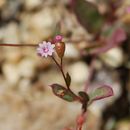Description
(
Inglês
)
fornecido por eFloras
Herbs, annual; taproot tapered, soft or ± woody. Stems erect to decumbent-ascending, sparingly to profusely branched throughout, 2-8(-15) dm, usually minutely puberulent, often also with long, spreading hairs, occasionally also glandular basally, glabrous distally. Leaves mostly in basal 1/2; larger leaves with petiole 5-30 mm, blade lanceolate, ovate, oval, deltate-ovate, or narrowly deltate, 10-50 × 6-32 mm (distal leaves usually shorter, proportionately narrower), adaxial surface usually glabrous, sometimes sparsely hirtellous, abaxial surface paler than adaxial, usually glabrous, sometimes sparsely puberulent or with few coarse hairs, usually neither surface punctate, base acute, obtuse, or round, margins sinuate, often crisped, apex acute, obtuse, or rounded. Inflorescences terminal and axillary, forked ca. 2-5 times unevenly, usually with sticky internodal bands; branches strongly ascending, terminating in spicate or racemose flower clusters, axis 15-60 mm. Flowers: pedicel 0.1-1.6 mm; bracts at base of perianth soon deciduous, 1-2, usually lanceolate, lance-acuminate, or linear-lanceolate, rarely ovate, 0.4-1 mm; perianth white to pale pink, campanulate distal to constriction, 0.7-2 mm; stamens (1-)2-3(-4), included or slightly exserted. Fruits 4-20(-22) per cluster, remotely spaced or overlapped by 1-100% of their length, or 2-4 in group, separated by small gap from next group and with distal spikelets overlapping, straw colored to pale red-brown, narrowly obovoid to narrowly obpyramidal, 2-3.2(-3.6) × 0.9-1.1(-1.4) mm (l/w: [1.9-]2.1-3.1[-3.3]), apex rounded to bluntly conic-truncate, or truncate, glabrous; ribs 5, obtuse or round-obtuse, often with sharp ridges, slightly rugose near sulci; sulci 0.1-0.3 times as wide as base of ribs, smooth or slightly rugose, not papillate.
- licença
- cc-by-nc-sa-3.0
- direitos autorais
- Missouri Botanical Garden, 4344 Shaw Boulevard, St. Louis, MO, 63110 USA
Synonym
(
Inglês
)
fornecido por eFloras
Senkenbergia coulteri Hooker f. in G. Bentham and J. D. Hooker, Gen. Pl. 3: 6. 1880
- licença
- cc-by-nc-sa-3.0
- direitos autorais
- Missouri Botanical Garden, 4344 Shaw Boulevard, St. Louis, MO, 63110 USA
Boerhavia coulteri
(
Inglês
)
fornecido por wikipedia EN
Boerhavia coulteri is a species of flowering plant in the four o'clock family known by the common name Coulter's spiderling. It is native to the southwestern United States and northern Mexico, particularly the desert areas. This is an annual herb producing an erect or creeping stem up to about 70 or 80 centimeters in maximum length. They are slightly hairy and have sticky resin glands toward the bases. The leaves are lance-shaped to somewhat triangular, pointed, sometimes wavy or rippled along the edges, and 5 centimeters in maximum length. Most of the leaves grow from the lower half of the plant. The sticky inflorescence is a small cluster of tiny white to pale pink flowers, each under two millimeters long. The fruit is an elliptical body a few millimeters in length with longitudinal ribs. The fruits are borne in small clusters.

- licença
- cc-by-sa-3.0
- direitos autorais
- Wikipedia authors and editors
Boerhavia coulteri: Brief Summary
(
Inglês
)
fornecido por wikipedia EN
Boerhavia coulteri is a species of flowering plant in the four o'clock family known by the common name Coulter's spiderling. It is native to the southwestern United States and northern Mexico, particularly the desert areas. This is an annual herb producing an erect or creeping stem up to about 70 or 80 centimeters in maximum length. They are slightly hairy and have sticky resin glands toward the bases. The leaves are lance-shaped to somewhat triangular, pointed, sometimes wavy or rippled along the edges, and 5 centimeters in maximum length. Most of the leaves grow from the lower half of the plant. The sticky inflorescence is a small cluster of tiny white to pale pink flowers, each under two millimeters long. The fruit is an elliptical body a few millimeters in length with longitudinal ribs. The fruits are borne in small clusters.
- licença
- cc-by-sa-3.0
- direitos autorais
- Wikipedia authors and editors

